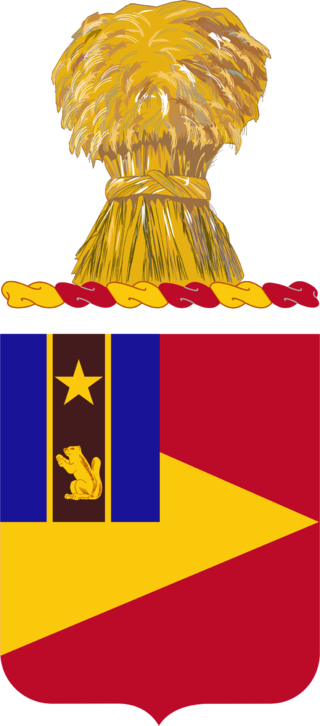The 200th Coast Artillery (AA) (200 CA) was a United States Army unit during the first half of World War II. Today descendant elements serve with the New Mexico Army National Guard as the 200th Infantry.
The 198th Signal Battalion is an Expeditionary Signal Battalion in the Delaware Army National Guard. Delaware is known as the "First State," as referenced in their motto "First Regiment of First State." The unit specializes in command post node communications, providing broadband satellite voice and data connections for brigade sized battlefield elements. The unit includes Headquarters, Headquarters Company located in Wilmington, DE; A Company in Georgetown, DE; B Company in Hodges, SC; and C Company in Wilmington, DE. It is one of several National Guard units with colonial roots and campaign credit for the War of 1812.

The 112th Infantry Regiment, also known as the Sixteenth Pennsylvania, is a unit in the Pennsylvania National Guard which can trace its lineage back to before the American Civil War.

The 108th Cavalry Regiment is a cavalry regiment of the Georgia and Louisiana Army National Guards of the United States Army.

The 4th Air Defense Artillery Regiment was constituted 1 June 1821 in the Regular Army as the 4th Regiment of Artillery and organized from new and existing units with headquarters at Pensacola, Florida. As a result of the division of the Artillery Corps into Coast and Field Artillery units, the Regiment was broken up 13 February 1901, and its elements reorganized and redesignated as separate numbered companies and batteries of the Artillery Corps.

The 3rd Air Defense Artillery Regiment is an air defense artillery regiment of the United States Army, first formed in 1821 as the 3rd Regiment of Artillery.

The 7th Air Defense Artillery Regiment is an air defense artillery regiment of the United States Army, first constituted in the Regular Army as the 7th Regiment of Artillery on 8 March 1898. The 6th and 7th U.S. Artillery Regiments were constituted on 8 March 1898, three weeks after the explosion of USS Maine in Havana, Cuba on 15 February 1898, as the United States' declaration of war on Spain and commencement of the Spanish–American War seemed imminent.

The 133rd Field Artillery Regiment is a parent field artillery regiment of the United States Army National Guard. It is currently represented in the Texas Army National Guard by the 1st, 3rd, and 4th Battalions.

The 6th Air Defense Artillery Regiment is an air defense artillery regiment in the United States Army, first formed in 1898 as the 6th Regiment of Artillery. The 6th and 7th U.S. Artillery Regiments were constituted on 8 March 1898, three weeks after the explosion of the USS Maine in Havana, Cuba on 15 February 1898, as the United States' declaration of war on Spain and commencement of the Spanish–American War seemed imminent.
The 10th Coast Artillery Regiment was a Coast Artillery regiment in the United States Army. It primarily served as the Regular Army coast artillery component of the Harbor Defenses (HD) of Narragansett Bay, Rhode Island from 1924 through 1944, when it was relieved and disbanded as part of an Army-wide reorganization.
The 62nd Air Defense Artillery Regiment is an Air Defense Artillery regiment in the United States Army. The lineages of some of the units that have been part of the 62nd Air Defense Artillery and its predecessors give the regiment campaign credit for the War of 1812.
The 63rd Coast Artillery was a Coast Artillery regiment in the United States Army. It was deactivated and broken up in 1943, with its last descendants inactivated in 1958.

The 197th Field Artillery Regiment is a regiment in the New Hampshire Army National Guard.
The 202nd Air Defense Artillery was an antiaircraft regiment of the Illinois Army National Guard.
The 212th Coast Artillery was a Coast Artillery regiment in the New York National Guard.
The 213th Air Defense Artillery is a regiment in the Pennsylvania Army National Guard.
The 251st Coast Artillery was a coast artillery regiment in the California National Guard, constituted in 1924 as a harbor defense regiment for the 9th Artillery District and re-designated in 1930 as an antiaircraft regiment. It served in World War II in that capacity.

The 265th Air Defense Artillery Regiment is an air defense artillery regiment in the Florida Army National Guard. The unit was formed 19 October 1923 in the Florida National Guard as the 1st Separate Battalion, Coast Artillery Corps. It was reorganized and redesignated as the 265th Coast Artillery Regiment (CA) (HD) in 1929. The 265th was activated for World War II and served in the harbor defenses of Galveston, Texas, Los Angeles, California, Key West, Florida, Sandy Hook, New Jersey, and Alaska until broken up into battalions in July 1944. The unit lineage was carried by two antiaircraft battalions organized in 1946, one of which was federalized in Florida during the Korean War. Consolidated with other units in 1959 as the 265th Artillery; reorganized in 1987 as the 265th Air Defense Artillery.

The 94th Cavalry Regiment is a United States Army cavalry regiment, represented in the Minnesota Army National Guard by 1st Squadron, 94th Cavalry, part of the 1st Armored Brigade Combat Team, 34th Infantry Division, stationed at Duluth.

The 429th Brigade Support Battalion is a combat service support battalion of the United States Army and the Virginia National Guard. It is part of the 116th Infantry Brigade Combat Team, Virginia Army National Guard.












